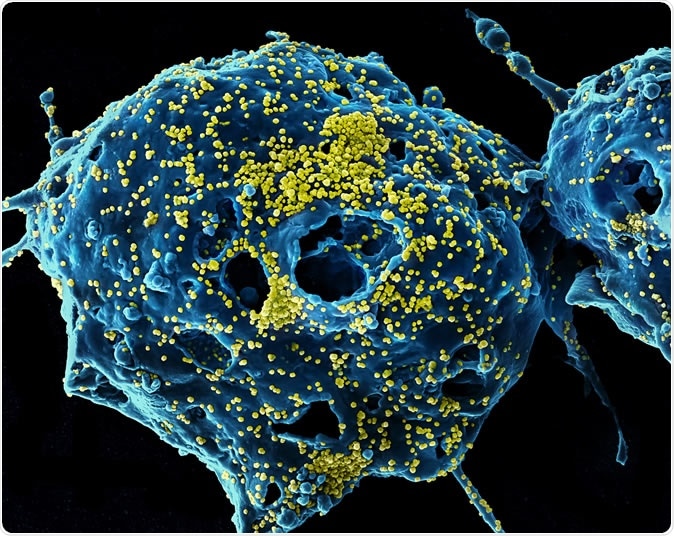A team of researchers from Rice University has won a National Science Foundation (NSF) RAPID grant to adapt their wastewater nanotechnology project to help trap and inactivate the severe acute respiratory syndrome coronavirus 2 (SARS-CoV-2), (which causes COVID-19 disease), in wastewater. This could help public health officials deal with the threat of disease transmission through wastewater.
The grant was provided to develop a "novel approach for selective adsorption and photocatalytic disinfection" ('trap and zap" approach) of the virus.
Pedro Alvarez, a civil and environmental engineer at Rice, and bioscientist Yizhi Jane Tao introduced their chemical-free nanotechnology as a method of "trapping and zapping" superbugs, or multidrug-resistant bacteria, in wastewater, earlier this year.
After capturing the bacteria via specially imprinted graphitic carbon nitride, the technology will break down the superbug antibiotic resistance genes in the wastewater.

MERS Virus Particles Colorized scanning electron micrograph of Middle East Respiratory Syndrome virus particles (yellow) attached to the surface of an infected VERO E6 cell (blue). Image captured and color-enhanced at the NIAID Integrated Research Facility in Fort Detrick, Maryland. Credit: NIAID
Nontoxic selective disinfection
The new project now targets viruses. It begins with the use of graphitic carbon nitride that has been specially imprinted at the molecular level with attachment factors for all coronaviruses. These molecules include sialic acids, heparin sulfate proteoglycan, and angiotensin-converting enzyme-related carboxypeptidase (ACE2)-associated peptides.
The molecules are then washed out by acid washing or other suitable means, leaving behind a cavity in the shape of the molecule. This will allow it to absorb viruses selectively near the reactive sites, resulting in dependable and high levels of disinfection.
The first step is therefore based on the hypothesis that improved surface recognition following the imprinting of the surface at a molecular level using common attachment factors will allow viruses to be selectively adsorbed near reactive or catalytic sites.
This is followed by the inactivation of the viruses by these catalysts located in the proximity, which are light-activated. This avoids the use of potentially toxic or dangerous products generated by the disinfection process. The team aims to develop a system that is fast, efficient, and reliable "under realistic scenarios."
The wastewater-COVID-19 problem
Alvarez expressed concerns that the ongoing COVID-19 pandemic might be a "dress rehearsal for even more lethal infectious diseases that are very difficult to control". The director of the Nanosystems Engineering Research Center for Nanotechnology-Enabled Water Treatment (NEWT) emphasizes the need for public health strategies to extend to wastewater treatment processes.
Although conventional wastewater treatments might inactivate the virus, viral disinfection measures need to be more "precise," he added.
The team cited examples of SARS-CoV-2 being found in air ducts of buildings, suggesting it spreads via air conditioning systems. Other reports say it was found in the stool of patients who tested negative for COVID-19. According to the study abstract, some reports even say it spreads through bathroom pipes. This suggests that the spread of the virus to wastewater is likely.
"It could survive for days and be aerosolized or discharged in effluent", researchers say.
"We need to enhance the capacity and resiliency of multimedia treatment processes -- especially air filtration and wastewater disinfection -- to protect public health," Alvarez states.
Broader impacts
The team will be using a model coronavirus like HCoV-NL63, which is similar to SARS-CoV-2 but low in pathogenicity, to assess the selectivity and rate of adsorption of the imprinted graphitic carbon nitride in the presence of other molecules like bovine serum albumin, or the bacteriophage MS2.
The catalyst will be tested against traditional disinfection methods like chlorination and ultraviolet irradiation to see how it competes with them. Finally, researchers will try to find out to what extent it can be reused.
Currently, the research team plans to prepare their treatment using a similar but less dangerous virus that simulates SARS-CoV-2. However, they are hopeful that the trap-and-zap treatment will recognize coronaviruses other than SARS-CoV-2, including the SARS and MERS viruses, and prove effective in controlling them.
The grant abstract says, "Whereas enhancing the capacity and resiliency of wastewater disinfection and hospital air sterilization systems to protect public health against emerging infectious diseases has significant intrinsic merit, the benefits of this project are much broader."
It involves not just disinfection but the ability to concentrate the coronavirus and to develop more precise methods of separating different types of viruses, such as by the use of better absorbent surfaces, and sensing viruses, by determining reliable detection limits. These sensors are essential for diagnostic and surveillance efforts as well.
The results from the project are slated to be incorporated into courses taught to various teachers' courses in different universities. This will help to popularize this chemical-free disinfection approach, which could keep wastewater free of pathogenic viruses and help control viral spread via wastewater.